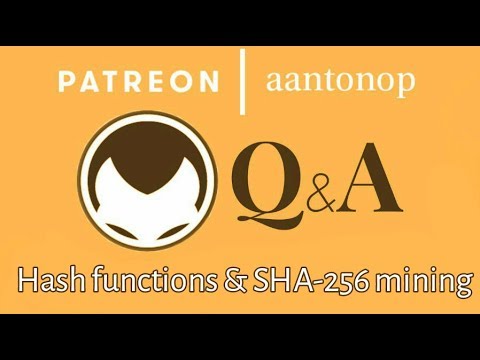[SESSION 2] 21:49 to 26:14 – How does a hash function work? Can you reverse a hash function?
[SESSION 3] 27:16 to 34:44 – Risks of dependence on SHA-256? Mining algorithm the most complicated. What is the purpose of double hashing to produce the address?
These questions are from the second and third sessions of MOOC 12, which took place on September 19th and September 27th 2019 respectively. If you want early-access to talks and a chance to participate in the monthly live Q&As with Andreas, become a patron: https://www.patreon.com/aantonop
RELATED:
Measuring Success: Price or Principle – https://youtu.be/mPMsbgWl9p4
Beyond Price: Bitcoin’s Impact on the Future – https://youtu.be/rvwVbRQ5Ysc
Consensus Algorithms, Blockchain Technology, and Bitcoin – https://youtu.be/fw3WkySh_Ho
Advanced Bitcoin Scripting Part 1: Transactions and Multisig – https://youtu.be/8FeAXjkmDcQ
Advanced Bitcoin Scripting Part 2: SegWit, Consensus, and Trustware – https://youtu.be/pQbeBduVQ4I
What is Consensus: Rules without Rulers – https://youtu.be/2tqo7PX5Pyc
Forkology: A Study of Forks for Newbies – https://youtu.be/rpeceXY1QBM
Bitcoin: Where the Laws of Mathematics Prevail – https://youtu.be/HaJ1hvon0E0
Software distribution security – https://youtu.be/_V0vqy046YM
What is mining? – https://youtu.be/t4p4iMqmxbQ
The mining process – https://youtu.be/L4Xtau0YMJw
Nonces, mining, and quantum computing – https://youtu.be/d4xXJh677J0
Iterating nonces and the block reward – https://youtu.be/tjn2aoMaFlY
Miners, pools, and consensus – https://youtu.be/JHz7LM4ncLw
Mining, energy prices, and fee market – https://youtu.be/hrVCd6Pt4l4
What is difficulty targeting? – https://youtu.be/h429LCTRmQw
Genesis block and coinbase transactions – https://youtu.be/strhfzJ56QE
Cryptographic primitives – https://youtu.be/RIckQ6RBt5E
The rules of Bitcoin (part 1) – https://youtu.be/VnQu4uylfOs
The rules of Bitcoin (part 2) – https://youtu.be/vtIp0GP4w1E
Rules versus rulers – https://youtu.be/9EEluhC9SxE
The value of proof-of-work – https://youtu.be/ZDGliHwstM8
Could a state-sponsored 51% attack work? – https://youtu.be/KUd8ZGgm6Qo
Honest nodes and consensus – https://youtu.be/KAhY2ymI-tg
Spam transactions and Child Pays For Parent (CPFP) – https://youtu.be/t3c0E4fkSNs
Is Bitcoin a democracy? – https://youtu.be/TC3Hq76UT5g
Governments versus Proof-of-Work or Proof-of-Stake – https://youtu.be/qrwgYDAoZV0
Decentralized power, leaderless governance – https://youtu.be/E5VbDlQTPzU
What is the role of nodes? – https://youtu.be/fNk7nYxTOyQ
Why running a node is important – https://youtu.be/oX0Yrv-6jVs
Spam transactions and Child Pays For Parent (CPFP) – https://youtu.be/t3c0E4fkSNs
Energy consumption – https://youtu.be/2T0OUIW89II
Solar energy and mining in space – https://youtu.be/cusakcpa8AM
Bitmain and ASICBoost allegations – https://youtu.be/t6jJDD2Aj8k
Binance hack, chain rollback? – https://youtu.be/2cZhkV6BqLg
Block reward, reorg protection, and immutability – https://youtu.be/R6KMp6vkeVU
Price and hashpower metrics – https://youtu.be/5JBulDoy8Xk
Medium of exchange, unit of account, and reserve currency – https://youtu.be/ExuHOCyje-w
Limited supply and block subsidy – https://youtu.be/18iCvz9WpjU
Mining incentives after 2140 – https://youtu.be/LNSlIiKyZJM
Andreas M. Antonopoulos is a technologist and serial entrepreneur who has become one of the most well-known and respected figures in Bitcoin. He is the author of “Mastering Bitcoin,” “The Internet of Money” series, and “Mastering Ethereum.”
Follow on Twitter: @aantonop https://twitter.com/aantonop
Website: https://antonopoulos.com/
Subscribe to the channel to learn more about Bitcoin & open blockchains; click on the red bell to enable notifications about new videos!
MASTERING BITCOIN, 2nd Edition: https://amzn.to/2xcdsY9
Translations of MASTERING BITCOIN: https://bitcoinbook.info/translations-of-mastering-bitcoin/
THE INTERNET OF MONEY, v1: https://amzn.to/2ykmXFs
THE INTERNET OF MONEY, v2: https://amzn.to/2IIG5BJ
Translations of THE INTERNET OF MONEY:
Spanish, ‘Internet del Dinero’ (v1) – https://amzn.to/2yoaTTq
German, ‘Das Internet des Geldes’ (v1) – https://amzn.to/2LEiyqO
German, ‘Das Internet des Geldes’ (v2) – https://amzn.to/2VCzse5
French, ‘L’internet de l’argent’ (v1) – https://www.amazon.fr/Linternet-largent-Andreas-M-Antonopoulos/dp/2856083390
Russian, ‘Интернет денег’ (v1) – https://www.olbuss.ru/catalog/ekonomika-i-biznes/korporativnye-finansy-bankovskoe-delo/internet-deneg
Vietnamese, ‘Internet Của Tiền Tệ’ (v1) – https://alphabooks.vn/khi-tien-len-mang
MASTERING ETHEREUM: https://amzn.to/2xdxmlK
Music: “Unbounded” by Orfan (https://twitter.com/grassfedbitcoin)
Outro Graphics: Phneep (http://www.phneep.com/)
Outro Art: Rock Barcellos (http://www.rockincomics.com.br/)
source


















Thanks for the explanation! great video as always
I don't get ASIC-Boost – what I've understood:
mining costs less electricity because the ASIC-Boost was implemented
-> mining gets easier
-> we mine faster
-> difficulty rises
-> …
Do we not need more energy if difficulty rises or how did ASIC-Boost reduce electricity?
brilliant billiard ball analogy
It's correct that you possible can creact the same hash for some bit stream, but if the data in package also has to make sense for an protocol special if you have a length field is extremely difficult. I ever think that for this purpose md5sum is till pretty difficult to break
Smashed the like
why 2 times sha?
Go over to Roger Ver and talk to him, don't run away
now I know how to explain hashing to people new to bitcoin
It's Thanksgiving and I'm thankful for crypto and Andreas ?
First